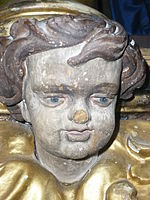Maria Visitation (Pfronten)
The Chapel of the Visitation of Mary is a place of worship in the Pfronten district of Meilingen. It is a branch of the parish church of St. Nikolaus in Pfronten-Berg.
history
The Chapel of the Visitation of Mary is in the Burgweg district of Meilingen. This settlement was probably created when a road to the new Falkenstein Castle was built around 1290 . Possibly the origin of the chapel goes back to that time. In a report to the Ordinariate from 1658 it is mentioned for the first time and in 1664 it is described as "ancient".
Her older name is "Our Lady in Burgweg". Now the name "Maria Hilf" has established itself in the vernacular. This designation was probably given to the chapel by pregnant women who came here and prayed for a happy birth in front of the miraculous image of Our Lady. This is reported as early as 1738.
Building description
The rectangular nave with two window axes is followed by a slightly drawn-in choir, closed on three sides, with another window axis. On the south side, a sacristy and an arena have been added to the original chapel. In the octagonal roof turret hangs a small bell from 1644. It had to be cast after 1945 after it came back from the war-related delivery with a crack.
Inside, the choir is separated from the nave with a western gallery by a strong arch. The ceiling is flat and has a hollow. The stucco in the choir vault with early baroque rod shapes comes from Jakob Miller from Wessobrunn. The last thorough renovation of the chapel was completed in 1973.
Furnishing
The three high baroque altars, carved by Nikolaus Babel in 1686 and set by Johann Rudolf Bösinger, are an essential part of the church decorations. Both received 46 guilders 30 kreuzers for their work. The half-figure of God the Father, framed by St. Joachim and an Anna Selbdritt, is enthroned in the extension of the high altar. Angel figures on the altar gables and angel heads on the columns and capitals give the altars a particularly festive look.
St. Joseph with the Christ child on the left side altar must be made by the Pfronten sculptor Mang Anton Stapf (1701–1772). In Nazarene Karl Keller painted (1823-1904) today's high altar. The 14 Stations of the Cross are oil paintings on canvas that have been pasted onto wooden panels. They are unsigned and date from the middle of the 18th century.
The origin of the miraculous image on the right side altar, a Mother of God with the Christ child, is not clear. An old, probably smaller, Madonna was clad in baroque style in 1686 with taffeta , braids and ribbons. In 1801 the carpenter Joseph Anton Münz von Pfronten-Kreuzegg (1772-?) Rebuilt the altar and enlarged the shell niche. There a “new” picture of Our Lady was put up by him, which was taken by Alois Kögel (1753-1830) from Pfronten. It is not known where the Madonna originally came from, it does not seem to be the work of a Pfronten sculptor. The origin of the Baby Jesus, who stylistically does not match the Mother of God, is not documented either. Both figures have always been dressed. In 1980 they were completely restored.
- Angel heads by Nikolaus Babel on the side altars
literature
- Annemarie and Adolf Schröppel: Pfrontener churches and chapels and their pastors , in: “Encounter” (parish letters of the parish of St. Nicholas), collected articles, ed. from Heimatverein Pfronten 2002 (The well-founded articles do not provide any source information, but are essentially based on church accounts, some of which have been preserved in the Pfronten parish archive from 1674 to 1804 for the Maria Visitation Chapel.)
- Anton H. Konrad / Annemarie and Adolf Schröppel: The Parish of Pfronten , Schwäbische Kunstdenkmale booklet 34, Weißenhorn 1986
- Michael Petzet: Bavarian Art Monuments - City and District of Füssen , Deutscher Kunstverlag, Munich 1960, p. 133
Web links
Individual evidence
- ↑ Quoted here from Annemarie and Adolf Schröppel, Pfrontener Kirchen und Kapellen und Ihr Pfarrer, p. 60. The source can be found in the ordinary files of the Augsburg diocese archives.
- ↑ z. B. Augsburg State Archives, Letters from the Pfronten Administrative Offices, Augsburg Nursing Offices, Vol. 249, p. 262
- ↑ Quoted here from Annemarie and Adolf Schröppel, Pfrontener Kirchen und Kapellen und Ihr Pfarrer, p. 61
- ^ Bailiff in Pfronten, named 1687–1700
- ^ Based on Konrad / Schröppel by Maximilian Hitzelberger
- ↑ Annemarie Schröppel, 1980, in a letter to the restorer Frau Dr. Gebhardt, Schröppelarchiv in the municipality of Pfronten (folder: Pfrontener Kapellen)
Coordinates: 47 ° 34 ′ 40.5 ″ N , 10 ° 34 ′ 14 ″ E







